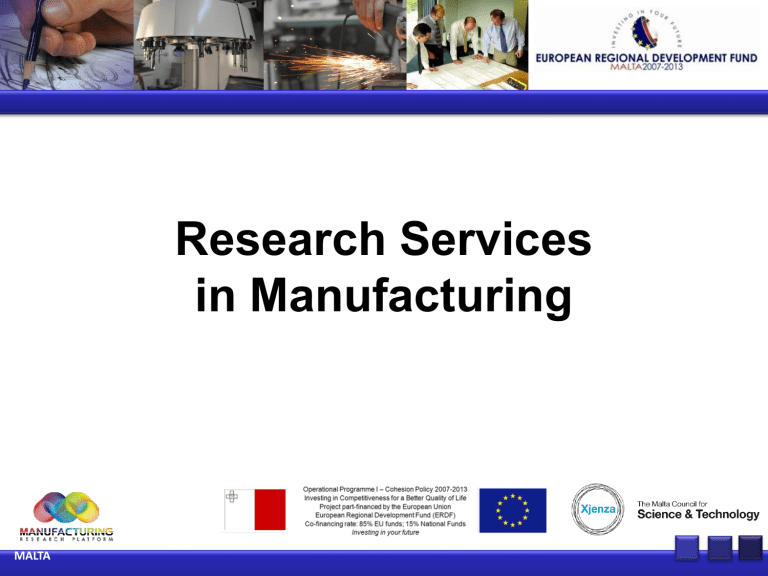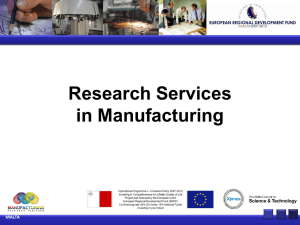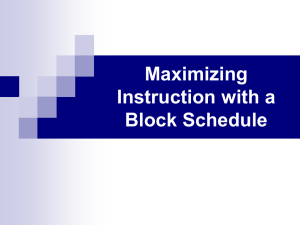ICT in Manufacturing - Manufacturing Research Platform

MALTA
Research Services in Manufacturing
Exploiting ICT for the Maltese
Manufacturing Industry
Key Experts:
Researchers:
Dr Ernest Cachia
Dr John Abela
Dr Ing Saviour Zammit
Mr Armand Sciberras
Mr Joseph Bonello
ICT in Manufacturing
• History of Manufacturing
– Assembly line (Henry Ford)
– Robots
• Increasingly on the path of innovation
– To offer a broadened service range fulfilling world-wide customer requirements
ICT in Manufacturing
• ICT potential
– Fast
– Accurate
– Reliable
– Updateable
– Centralised Data
– Assets remain in the company
Process 1 – Automated
Optimisation of
Production Lines
Importance of Manufacturing
• The Manufacturing Industry operates in a very competitive market
– Requires continuous innovation
– Needs to provide added value services
• Lower Costs
• Higher Productivity
• Faster product turnout
• Better planning
• Reduce Order-To-Shipping time
Importance of Manufacturing
• Efficient Scheduling and Planning are main contributors to cost reduction and efficiency
– Helps the company allocate and prepare resources to meet demand
• ICT can add value by providing low-cost tools that aid companies
– Understand the scheduling problems they face
– Provide near-optimal schedules
Scheduling in Manufacturing
• Scheduling refers to the problem of finding an efficient sequence of utilisation of human and machine resources
• An efficient schedule reduces costs through optimal allocation of resources
• But it is a very difficult problem
– Enumerating all possible schedules takes too long to be feasible
Scheduling in Manufacturing
• In Computer Science, scheduling problems are well known
– As examples of computationally complex problems
– As being notoriously difficult to find an algorithm to solve them efficiently
• Computationally complex problems cannot be solved in a “reasonable” amount of time
Scheduling in Manufacturing
• To determine an optimal schedule, one must analyse the performance of all possible solutions of the problem
– Enumerating all the possible solutions takes a very long time
• Also difficult is determining the type of problem one has
– Thus one is not sure how difficult the problem is
Scheduling in Manufacturing
• Operators have a number of rules that help them find a schedule
• Not always accurate and not necessarily optimal
• The project aims at helping operators by
– Helping them identify the problem
– Help them identify the complexity of the problem
– Provide them with tools to generate a schedule
Scheduling in Manufacturing
• The project helps operators model production lines using Graphs
• The graph visually represents the relationship between resources, jobs and operations
• Additional information is captured to allow the application to detect the complexity index of the problem
Scheduling in Manufacturing
• The following types of problems can be modelled:
– Single Machine Problems: Bottleneck machine
Problems
– Parallel Machine Problems: Jobs can be processed on any of the different machines available
– Shop Problems: Machines are dedicated to a particular operation of a job
(Multi-Operation Model)
Scheduling in Manufacturing
• The application is able to classify scheduling problems in the following categories:
– Polynomially Solvable: These are the “easy” problems i.e. one can obtain a schedule is a reasonable timeframe
– Pseudo-polynomially Solvable: Problems that are “easy” within certain bounds
– NP-Hard: These are “hard” problems, it is difficult to obtain a schedule for these problems
– Open: problems for which the complexity status is not known
Scheduling in Manufacturing
• Schedule generation depends on the type of problem
– Easy problems have an efficient algorithm
– Hard problems may be approximated using different techniques
• Using heuristic techniques such as Genetic
Algorithms
• Using mathematical solutions such as approximation algorithms
Scheduling in Manufacturing
• Generated schedules for hard problems are near-optimal
– Finding the optimal schedule is not possible
– Heuristic methods provide a
“good” trade-off between time to generate the schedule and optimality
– Usually better than a humangenerated schedule due to computer’s speed in analysing solutions
Scheduling in Manufacturing
• A number of schedule generation solutions are being investigated
– A generic solver based on Genetic
Algorithms
– Solvers based on mathematic formulations
• The proposed solution has a plugin system aimed at
– Extensibility to allow addition of new algorithms and solvers
Process 2 – Automated QA for Print Output using Neural Networks
Quality Assurance in Manufacturing
• Quality is a key factor in the selling price of manufactured goods
• Quality inspection is traditionally done by human beings either:
• At the end of the production line on each and every item removing defective products (slow and expensive)
• Inspecting samples from a produced batch and assessing a batch quality (defective products are left in batch)
Motivation
• Human inspection:
• Not adequate for certain inspection jobs
• Not accurate enough
• Slow and expensive
• Not consistent and decisions vary from one inspector to the other
• With recent advances in hardware and development of AI techniques automating the inspection process is more possible
Printing in an industrial setup
• Printing is usually carried out using:
• Pad printing
• Hot-foil stamping
• Offset printing
• Silk-screen printing
Printing Problems
• All the printing techniques have their own advantages and disadvantages and are prone to particular defects
• Changes in temperature
• Sensitive to different surfaces
• Incorrect ink mixtures
• etc.
• Preventing changes to these variables is generally either impossible or very expensive
Common Defects
• Scratches and cracks
• Missing or extra ink
• Missing or incorrectly placed components on PCBs
• Smudges and misalignment defects
Advantages of an automated system
• Reliable 24x7
• Accurate
• Fast
• Consistent
• Cheap
Towards an automated system
• The project aims at helping operators by
• Guiding them in training and setting up an automated classifier system for manufactured goods
• Speed up the inspection process of manufactured goods
• Increase the quality of manufactured goods
Automated Optical Inspection
Image capturing
Output from
Classifier
Image correction, background removal, image segmentation
Data Input to
Classifier and other
QA tests
Further image processing and feature extraction
Image Processing
• Alignment
• Depending on the setup used, images can be aligned to a template
• Background removal
• Unwanted areas from the image can be removed through masks and region selection
• Captured images can be broken down into regions using intelligent algorithms in order to be treated separately
Artificial Neural Networks
• Mathematical models inspired from the structure and functional aspects of biological neural networks
• Made up of an interconnected group of artificial neurons
• Based on input, the structure and connections of the network change accordingly to learn a particular task
• Great for modelling complex relationships between inputs and outputs
The WISARD Neural Network
• At training stages the provided data is extracted from the image and stored in the nodes
• During live mode, the data is extracted the same way from the image and tested in the nodes
• A similarity percentage is calculated and the object can be discarded if the value is under a specific threshold
Other tests
• Additional QA tests can be set to run in parallel with the neural network
• Label offset
• Checking that a specified label printed on the product is contained in a specified boundary
• Colour inclusion/exclusion
• Checking for the presence of areas defined by colour and size at specified areas
• Optical Character Recognition
• Checking text at specified areas
Classification
• All QA tests selected during setup time are executed on the captured image of the product
• All tests can either fail or pass
• The tool determines whether the product should be discarded or not
Thank you for listening






